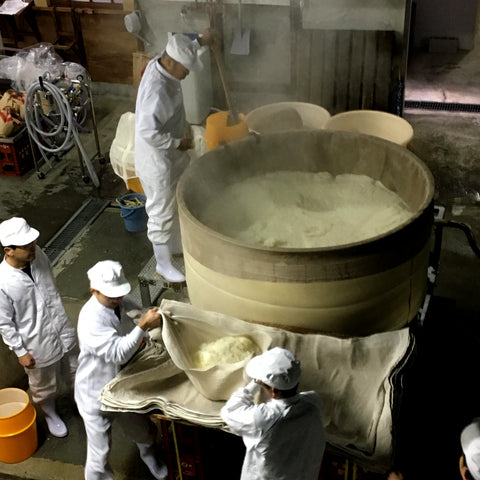 Yuji Nakamura, head saker brewer and whisky distiller at Eigashima Shuzo
Yuji Nakamura, head saker brewer and whisky distiller at Eigashima ShuzoFor August, we are bringing in Eigashima Shuzo's Kamitaka “Octopus Label” Mizumoto Junmai. We have been carrying Eigashima Shuzo's Akashi Whisky since 2018. As an introduction to the distillery, Kayoko wrote the following on our blog back in 2018, "Eigashima Shuzo, famed for its sake since the Edo period (1603-1868), is one of Japan's oldest whisky distilleries. The first to obtain their distillery license in 1919, they began making shochu and other spirits. Since 1984, they have been producing Akashi Whiskies at their White Oak facility in the seaside town of Akashi, near Kobe. Today, they continue to produce sake, umeshu, whisky."
We were delighted when this sake was introduced stateside. And I was even more excited by the fact that it was a mizumoto. Below, I asked Yuji Nakamura, the head sake brewer, and whisky blender and distiller at Eigashima Shuzo about the concepts and processes behind which this sake is brewed.
Yoko: What is the concept behind this sake?
Nakamura-san: It's a return to the origins of sake, to its original taste.
Yoko: Can you tell me about the difference between bodaimoto and mizumoto?
Nakamura-san: I consider it to be basically the same. Bodaimoto in Shoryakuji temple in Nara, and as it spread throughout the country, it was given the name mizumoto. This method was invented during the Muromachi period about 500 years ago.
Yoko: Where did you learn how to make mizumoto?
Nakamura-san: I learned how to make mizumoto at a brewery in Nara Prefecture where I previously worked, and in 2016 I was appointed as the head brewer at Eigashima Sake Brewery. As no brewery in Hyogo Prefecture had adopted this manufacturing method yet, I realized that it was a unique process. I incorporated mizumoto, thinking that it could be one of the definitive characteristics of Kamitaka sake as I took over.

Steaming rice at Eigashima Shuzo
Yoko: What surprised or made you happy during the process of making mizumoto?
Nakamura-san: I was surprised that the scent was completely different from the current method. Although it is an ancient manufacturing method, the finished product is delicious alcohol, so I was interested in the wisdom of our ancestors.
Yoko: Can you tell me a simple recipe that goes well with this sake?
Nakamura-san: It goes well with stewed octopus and seaweed, which are Akashi's specialties, as well as cheese.
Yoko: Ah, the label makes sense now. Who designed it?
Nakamura-san: A printing company we work with asked us if we would like to use a label with the image of an octopus, a specialty of Akashi, and we decided to use it because we thought it was a must-have label for mizumoto.
Yoko: What are some tasting notes you get in this sake?
Nakamura-san: This sake has aromas of ripe apricots, persimmons, and narazuke (Japanese pickles). There's also an acidic taste that enhances the sweetness and flavor. The deep flavor of rice continues in its finish.
 Kamitaka “Octopus Label” Mizumoto Junmai paired with BBQ oysters
Kamitaka “Octopus Label” Mizumoto Junmai paired with BBQ oysters
Yoko: Yes, I loved these earthy notes with fuller flavors like aged gouda and barbequed oysters!
Thank you for taking the time to shine some light on this sake. We'll continue to enjoy your sakes and whisky from afar and will visit next time we are in Kobe!




Comments (0)
There are no comments for this article. Be the first one to leave a message!